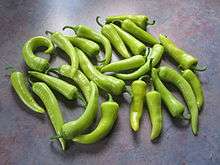Banana pepper
| Banana Pepper | |
|---|---|
 Yellow Wax Peppers | |
| Species | Capsicum annuum |
| Heat |
|
| Scoville scale | 0-500 SHU |
The banana pepper (also known as the yellow wax pepper or banana chili) is a medium-sized member of the chili pepper family that has a mild, tangy taste. While typically bright yellow, it is possible for them to change to green, red, or orange as they ripen. It is often pickled, stuffed or used as a raw ingredient in foods. It is a cultivar of the species Capsicum annuum. Its flavor is not very hot (0–500 Scoville units), and as is the case with most peppers, its heat depends on the maturity of the pepper, with the ripest being sweeter than younger ones.
Nomenclature
A mature fruit will be about 2-3 inches (5–8 cm) in length and have a curved shape and yellowish color similar to a banana, giving rise to the fruit's common name. Friggitelli (pepperoncini) are often erroneously referred to as banana peppers and immature Hungarian wax peppers are frequently mistaken for them. It's not uncommon for Hungarian wax peppers to be sold in bunches of banana peppers providing more heat and less sweetness than would be expected.

Cultivation
The plant requires full sun, like other Capsicum annuum varieties, and should be treated the same as most other plants in the pepper family. Plants can be grown from seed and cuttings. The hot varieties of Banana pepper are called Hungarian Wax Peppers. Cultivars include Early Sweet Banana, Hungarian Yellow Wax, Sweet Banana, Sweet Hungarian.[1] A mature plant will reach 1 to 2 feet tall and can be grown in many climates, but prefer warmer climates.
Nutritional information
| Nutritional value per 100 g | |
|---|---|
| Energy | 113 kJ (27 kcal) |
|
5.3 g | |
| Sugars | 1.9 g |
| Dietary fiber | 3.4 g |
|
.5 g | |
|
1.7 g | |
| Vitamins | |
| Vitamin A | 340 IU |
| Thiamine (B1) |
(9%) 0.1 mg |
| Riboflavin (B2) |
(8%) 0.1 mg |
| Niacin (B3) |
(8%) 1.2 mg |
| Pantothenic acid (B5) |
(6%) 0.3 mg |
| Vitamin B6 |
(31%) 0.4 mg |
| Folate (B9) |
(7%) 29 μg |
| Vitamin C |
(100%) 82.7 mg |
| Minerals | |
| Calcium |
(1%) 14 mg |
| Iron |
(4%) 0.5 mg |
| Magnesium |
(5%) 17 mg |
| Phosphorus |
(5%) 32 mg |
| Potassium |
(5%) 256 mg |
| Zinc |
(3%) 0.3 mg |
| |
|
Percentages are roughly approximated using US recommendations for adults. Source: USDA Nutrient Database | |
Banana peppers are a good source of dietary fiber, vitamin A, potassium and a very good source of vitamin C.[2]
Serving styles
- Pickled banana peppers are commonly sold sliced and used to garnish pizzas, sandwiches and Greek salads.
- Pickled and stuffed banana peppers are common inclusions on Antipasto bars filled with prosciutto and/or cheese.
- Stuffed banana peppers are served warm with a variety of Italian sausage and cheeses.
- Chopped or diced banana peppers are used in many relishes and salsas to add sweetness with other peppers providing heat.
- Banana peppers may be jellied along with other hot green peppers such as jalapeños.
See also
References
- ↑ Jean Andrews (1995). Peppers: The Domesticated Capsicums, New Edition. University of Texas Press. p. 97. ISBN 978-0-292-70467-1. Retrieved 31 August 2012.
- ↑ Livestrong: Are Banana Peppers Good For You?